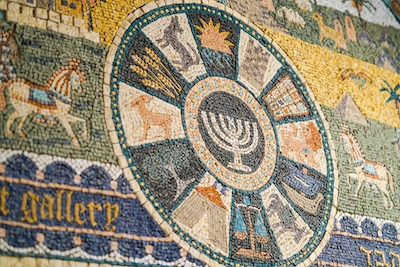A lengthy mishnah on today’s daf begins:
One who sells the head of a large domesticated animal has not sold the forelegs with it. If one sold the forelegs he has not sold the head. Similarly, if one sold the windpipe and the lungs he has not sold the liver, and if he sold the liver he has not sold the windpipe and lungs. But in the case of small domesticated animals, if one sold the head he has sold the forelegs, although if one sold the legs he has not sold the head. Likewise, if one sold the windpipe and lungs he has sold the liver, but if he sold the liver he has not sold the windpipe and lungs.
In earlier mishnahs, when discussing the sale of animals, we considered things like whether their equipment was included, but never sections of the animal itself. This is because previously we were discussing work animals, like donkeys and oxen. But kosher domesticated animals are frequently sold for their meat, so they can be sold in pieces.
With large domesticated animals (such as cows), each section of the body can be sold separately. In the case of smaller domesticated animals (such as sheep or goats), some parts, such as the head and legs, are sold together frequently enough that if the more significant body part is sold, the latter is included implicitly.
This first half of the mishnah is consistent with the main topic of our last two chapters: items that are automatically included in a sale. But in the second half, the mishnah seems to alter its focus:
There are four basic cases with regard to sellers and buyers. If the seller sold him wheat and said that the wheat was good, and it is found to be bad, the buyer can renege. If the seller sold him what he said was bad wheat and it is found to be good, the seller can renege. If he sold bad wheat and it is found to be bad, or good wheat and it is found to be good, neither one of them can renege.
If the seller sold reddish-brown wheat and it is found to be white, or white wheat and it is found to be reddish-brown, and if he sold olive wood and it is found to be sycamore wood, or he sold sycamore wood and it is found to be olive wood, or if the seller sold him wine and it is found to be vinegar, or vinegar and it is found to be wine — in all of these cases both the seller and the buyer can renege.
The mishnah has suddenly swerved to a very different set of questions: If the item sold does not match the item delivered, can the sale be cancelled? From this mishnah, we may infer four basic principles:
(1) If the item sold is of worse quality than advertised, the buyer can renege.
(2) If the item sold is of better quality than advertised, the seller can renege.
(3) If the item sold is of the type and quality advertised, neither party can renege.
(4) If the item sold is different than advertised, regardless of quality, either party can renege.
While this section continues the broader theme of what implicit and explicit assumptions are made when conducting a sale, the switch from one topic to the next isn’t indicated with any transitional language, and doesn’t feel completely intuitive.
All of the mishnahs found in the Talmud are also collected in a book called simply the Mishnah which is divided into tractates, then chapters and finally individual mishnahs. Though the Talmud always preserves the order of the mishnahs found in the Mishnah, it doesn’t always use the same divisions between mishnahs. That is, sometimes only half of a mishnah will appear on a daf before the Gemara begins, or two mishnahs will be combined into one. Today’s daf is a case of the latter: While in the Mishnah these are two separate mishnahs, on our daf they appear run together, despite the incongruity in subjects. It’s likely the two were combined because there’s no independent discussion in the Gemara of the domesticated animal sale (the first part). So, rather than tack this section on to the mishnahs about the sale of trees and land, which came earlier and have extensive discussion in the Gemara, the Talmud’s compilers decided to squeeze it onto today’s daf before shifting topics.
Read all of Bava Batra 83 on Sefaria.
This piece originally appeared in a My Jewish Learning Daf Yomi email newsletter sent on September 16, 2024. If you are interested in receiving the newsletter, sign up here.

Help us keep Jewish knowledge accessible to millions of people around the world.
Your donation to My Jewish Learning fuels endless journeys of Jewish discovery. With your help, My Jewish Learning can continue to provide nonstop opportunities for learning, connection and growth.



